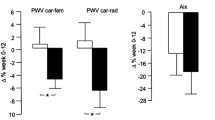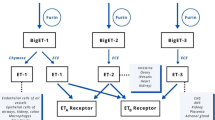Abstract
Endothelins are potent 21 amino acid vasoconstrictor isopeptides produced in different vascular tissues, including vascular endothelium. Endothelin-1 is the main endothelin generated by the endothelium and probably the most important in the cardiovascular system. Endothelin-1 acts through specific receptors termed ETA, represented only on smooth muscle cells and having the function of growth promotion and mediating contractions, and ETB, located both on smooth muscle cells, where they evoke contractions, and on endothelial cells, inducing relaxation by production of the endothelium-derived relaxing factor nitric oxide. In physiological conditions endothelin-1 administration causes vasodilation and vasoconstriction at low and high concentrations, respectively. However, administration of mixed ETA/B receptor antagonists causes slight or absent vasodilation, indicating that the direct vasoconstrictor effect of the peptide is probably masked by ETB-induced NO-dependent vasodilation. In essential hypertensive patients, the activity of exogenous endothelin-1 is either increased, similar or decreased as compared to normotensive subjects, depending on which vascular district or scheme of administration is considered. But although available evidence does not indicate increased endothelin-1 plasma levels in patients with essential hypertension, simultaneous antagonism of ETA/B receptors causes a greater degree of vasodilation in hypertensives than in normotensive subjects. Moreover administration of a selective ETB receptor antagonist causes vasoconstriction in normotensive subjects and vasodilation in essential hypertensive patients. Finally, the vasodilating effect of a mixed ETA/B receptor antagonist is inversely related to NO availability. Taken together these findings suggest that essential hypertension is characterized by increased endothelin-1 vasoconstrictor tone. This alteration seems to be dependent on decreased endothelial ETB-mediated NO production attributable to impaired NO availability. In such conditions endothelial ETB-induced vasodilation no longer compensates for the direct classical endothelin vasoconstrictor effect mediated by smooth muscle cell ETA and ETB receptors. Therefore endothelin-1 could potentially be involved in the pathogenesis of essential hypertension or of its complications, and blockade of this system is a fascinating new target for therapeutic intervention in this disease.
Similar content being viewed by others
References
Yanagisawa M, Kurihawa H, Kimura S, Tomobe Y, Koboyashi M, Mitsui Y, Yazaki Y, Goto K, Masaki T. A novel potent vasoconstrictor peptide produced by vascular endothelial cells. Nature 1988;332:411–415.
Inoue A, Yanagisawa M, Kimura S, Kasuya Y, Miyauchi T. The human endothelin family: 3 structurally and pharmacologically distinct isopeptides predicted by 3 separate genes. Proc Natl Acad Sci USA 1989;86:2863–2867.
Xu D, Emoto N, Giaid A, Slaughter C, Kaw S, deWit D, Yanagisawa M. A membrane bound metalloprotease that catalyses the proteolytic activation of big endothelin-1. Cell 1994;78:473–485.
Arai H, Hori S, Aramori I, Ohkubo H, Nakanishi S. Cloning and expression of a cDNA encoding an endothelin receptor. Nature 1990;348:730–732.
Seo B, Oemar BS, Siebermann R, Segesser L, Luscher T. Both ETA and ETB receptors mediate contraction to endothelin-1 in human blood vessels. Circulation 1994;89:1203–1208.
Haynes WG, Strachan FE, Webb DJ. Endothelin ETA and ETB receptors cause vasoconstriction of human resistance and capacitance vessels in vivo. Circulation 1995;92:357–363.
Tsukahara H, Ende H, Magazine HI, Bahou WF, Gologorsky MS. Molecular and functional characterization of the non-isopeptide-selective ETB receptor in endothelial cells: receptor coupling to nitric oxide synthase. J Biol Chem 1994;269:21,778–21,785.
De Nucci G, Thomas R, D'Orleans Juste P, Antunes E, Walder C, Warner TD, Vane JR. Pressor effects of circulating endothelin are limited by its removal in the pulmonary circulation and by the release of prostacyclin and endothelium-derived relaxing factor. Proc Natl Acad Sci USA 1988;85:9797–9800.
Haynes WG, Webb DJ. Endothelin as a regulator of cardiovascular function in health and disease. J Hypertens 1998;16:1081–1098.
Schiffrin EL. Role of endothelin-1 in hypertension. Hypertension 1999;34[part 2]:876–881.
Davenport AP, Ashby MJ, Easton P, Ella S, Bedford J, Dickerson C. A sensitive radioimmunoassay measuring endothelin-like immunoreactivity in human plasma: comparison of levels in patients with essential hypertension and normotensive control subjects. Clin Sci 1990;78:261–264.
Schiffrin EL, Thibault G. Plasma endothelin in human essential hypertension. Am J Hypertens 1991; 4:303–308.
Haynes WG, Hand M, Johnstone H, Padfield P, Webb DJ. Direct and sympathetically mediated venoconstniction in essential hypertension: enhanced response to endothelin-1. J Clin Invest 1994; 94:1359–1364.
Kiowski W, Lüscher TF, Linder L, Bühler FR. Endothelin-1-induced vasoconstriction in humans. Reversal by calcium channel blockade but not by nitrovasodilators or endothelium-derived relaxing factor. Circulation 1991;83:469–475.
Williams DL, Jones KL, Pettibone DJ, Lis EV, Clineschmidt BV. Sarafotoxin S6c: an agonist which distinguishes between endothelin receptor subtypes. Biochem Biophys Res Commun 1991;175:556–561.
Haynes WG, Webb DJ. Contribution of endogenous generation of endothelin-1 to basal vascular tone. Lancet 1994;344:852–854.
Ihara M, Noguchi K, Saeki T, Fukuroda T, Tsuchida S, Kimura S, Fukami T, Ishikawa K, Nishikibe M, Yano M. Biological profiles of highly potent novel endothelin antagonists selective for ETA receptor. Life Sci 1992;50:247–255.
Watanabe T, Awane Y, Ikeda S, Fujiwara S, Kubo K, Kikuchi T, Kusumoto K, Wakimasu M, Fujino M. Pharmacology of a non-selective ETA and ETB receptor antagonist, TAK-044, and the inhibition of myocardial infarct size in rats. Br J Pharmacol 1995;114:949–954.
Haynes WG, Ferro CJ, O'Kane KPJ, Somerville D, Lomax CC, Webb DJ. Systemic endothelin receptor blockade decreases peripheral vascular resistance and blood pressure in humans. Circulation 1996;93: 1860–1870.
Ferro CJ, Haynes WG, Johnston NR, Lomax CC, Newby DE, Webb DJ. The peptide endothelin receptor antagonist, TAK-044, produces sustained inhibition of endothelin-1 mediated arteriolar vasoconstriction. Br J Clin Pharmacol 1997;44:377–383.
Taddei S, Virdis A, Ghiadoni L, Sudano I, Notari M, Salvetti A. Vasoconstriction to endogenous endothelin-1 is increased in the peripheral circulation of patients with essential hypertension. Circulation 1999;100: 1680–1683.
Verhaar MC, Strachan FE, Newby DE, Cruden NL, Koomans HA, Rabelink TJ, Webb DJ. Endothelin-A receptor antagonist-mediated vasodilation is attenuated by inhibition of nitric oxide synthesis and by endothelin B-receptor blockade. Circulation 1998;97: 752–756.
Stroes ESG, Lüscher TF, de Groot FG, Koomans HA, Rabelink TJ. Cyclosporin A increases nitric oxide activity in vivo. Hypertension 1997; 29:570–575.
Ishikawa K, Ihara M, Noguchi K, Mase T, Mino N, Saeki T, Fukuroda T, Fukami T, Ozaki S, Nagase T, Nishikibe M, Yano M. Biochemical and pharmacological profile of a potent and selective endothelin B-receptor antagonist, BQ-788. Proc Natl Acad Sci USA 1994;91:4892–4896.
Strachan FE, Spratt JC, Wilkinson IB, Johnston NR, Gray GA, Webb DJ. Systemic blockade of the endothelin-B receptor increases peripheral vascular resistance in healthymen. Hypertension 1999;33[part II]:581–585.
Cardillo C, Nambi SS, Kilcoyne CM, Choucair WK, Katz A, Quon MJ, Panza JA. Insulin stimulates both endothelin and nitric oxide activity in the human forearm. Circulation 1999;100:820–825.
Cardillo C, Kilcoyne CM, Cannon RO III, Panza JA. Interactions between nitric oxide and endothelin in the regulation of vascular tone of human resistance vessels in vivo. Hypertension 2000;35:1237–1241.
Komuro I, Kurihara H, Sugiyama T, Yoshizumi M, Takaku F, Yazaki Y. Endothelin stimulates c-fos and c-myc expression and proliferation of vascular smooth muscle cells. FEBS Lett 1988;238:249–252.
Garg UC, Hassid A. Nitric oxide-generating vasodilators and 8-bromo-cyclic guanosine monophosphate inhibit mitogenesis and proliferation of cultured rat vascular smooth muscle cells. J Clin Invest 1989;83: 1774–1777.
Boulanger G, Lüscher TF. Release of endothelin from the porcine aorta: inhibition by endothelium-derived nitric oxide. J Clin Invest 1990;85:587–590.
Kohno M, Yasunari K, Murakawa KI, Yokokawa K, Horio T, Fukui T, Takeda T. Plasma Immunoreactive endothelin in essential hypertension. Am J Med 1990; 88:614–618.
Saito Y, Nakao K, Mukoyama M, Imura H. Increased plasma endothelin levels in patients with essential hypertension. N Engl J Med 1990; 322:205.
Yoshimoto S, Ishizaki Y, Sasaki T, Murota SI. Effect of carbon dioxide and oxygen on endothelin production by cultured porcine cerebral endothelial cells. Stroke 1991;22:378–383.
Schiffrin EL, Deng LY, Larochelle P. Blunted effects of endothelin upon subcutaneous resistance arteries of mild essential hypertensive patients. J Hypertens 1992;10:437–444.
Taddei S, Virdis A, Ghiadoni L, Magagna A, Salvetti A. Vitamin C improves endothelium-dependent vasodilation by restoring nitric oxide activity in essential hypertension. Circulation 1998;97:2222–2229.
Cardillo C, Kilcoyne CM, Waclawiw M, Cannon RO III, Panza JA. Role of endothelin in the increased vascular tone of patients with essential hypertension. Hypertension 1999;33:753–758.
Ghiadoni L, Virdis A, Magagna A, Taddei S, Salvetti A. Effect of the angiotensin II receptor antagonist candesartan on endothelial function in patients with essential hypertension. Hypertension 2000; 35[part 2]:501–506.
Krum H, Viskoper RJ, Lacourcière Y, Budde M, Charlon V. The effect of an endothelin receptor antagonist, bosentan, on blood pressure in patients with essential hypertension. N Engl J Med 1998;338:784–790.
Author information
Authors and Affiliations
Rights and permissions
About this article
Cite this article
Taddei, S., Virdis, A., Ghiadoni, L. et al. Role of Endothelin in the Control of Peripheral Vascular Tone in Human Hypertension. Heart Fail Rev 6, 277–285 (2001). https://doi.org/10.1023/A:1011400124060
Issue Date:
DOI: https://doi.org/10.1023/A:1011400124060




